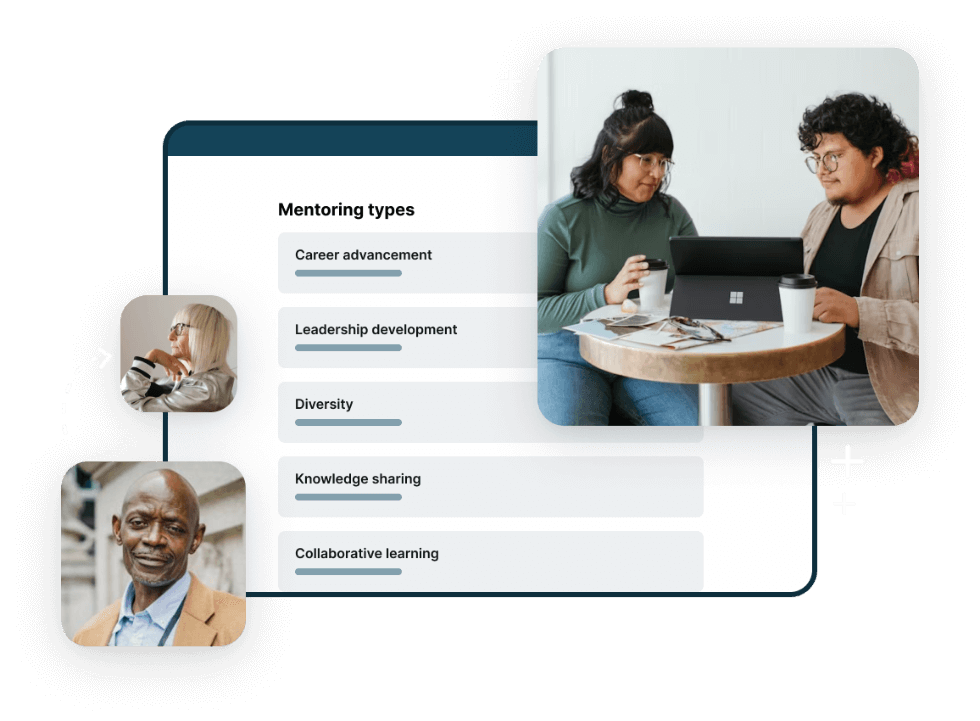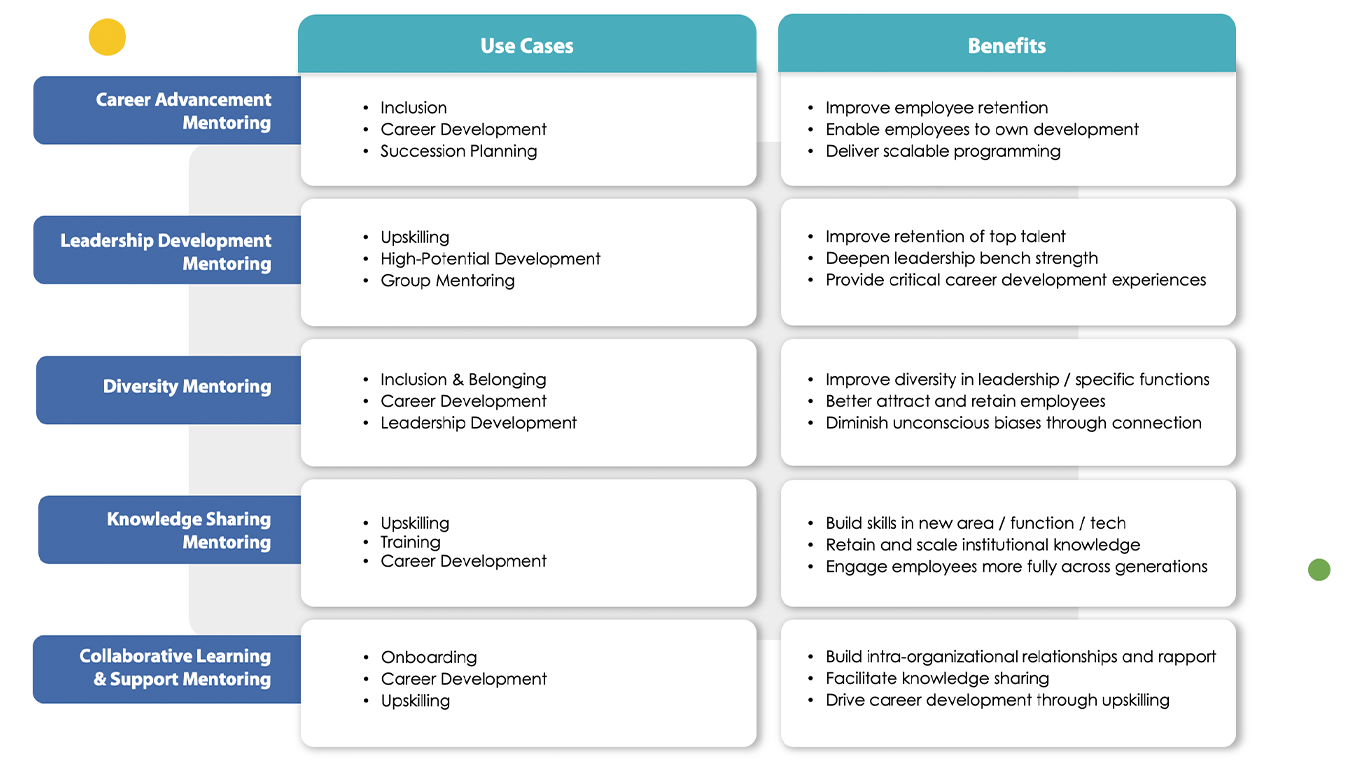🏆 How HCLTech Scaled Upskilling & Increased Retention 15% with Mentoring Read Case Study
5 Types of Mentoring
for the Workplace

Types of Mentoring in the Workplace
In the world of mentoring, various types of mentoring exist, each tailored to specific organizational needs and goals. These include traditional one-on-one mentoring, group mentoring, peer mentoring, reverse mentoring, and even flash mentoring. Choosing the right type of mentorship for your organization is crucial because it directly impacts the effectiveness and success of the mentoring program.
Different types of mentoring serve different purposes and cater to diverse employee needs.
Organizations must align their mentoring approach with their strategic objectives, employee demographics, and cultural values. The right choice ensures that mentoring programs not only address specific challenges but also promote inclusivity, skill development, and knowledge sharing, ultimately contributing to a more engaged and successful workforce. We’ve consulted our team of mentoring experts to determine the top five types of mentoring in the workplace. Read this guide to learn:
- The most prevalent types of mentorship in the workplace
- How each mentorship program works
- How companies benefit
- How employees benefit
Download Top 5 Workplace Mentoring Program Types
1. Career Advancement Mentoring
Career mentoring is by far the most common mentoring program we see in the workplace. This traditional one-to-one mentoring relationship can last 6-12 months.
How do companies benefit from career mentoring in the workplace?
To retain skilled employees and develop future leaders, it’s critical to understand employee career objectives and align them with organizational goals. Mentoring in organizations enables both career development and leadership development to help employees gain new skills and feel engaged with co-workers and your organization. By encouraging a learning culture through mentoring, companies ensure that employees take an active role in spreading knowledge and best practices throughout their organization. These factors all lead to happier employees and better employee retention for a stronger, more effective organization.
With career mentoring, you can:
- Improve employee retention
- Enable employees to take ownership of their development
- Deliver cost-effective, scalable programs with constrained HR resources
How do employees benefit from this type of mentoring in the workplace?
Employees get the opportunity for learning and development, which can help advance their careers and keep them from feeling stagnant in their roles. Offering a formal career mentoring program is a tangible way to show employees that you’re investing in their careers. The true ROI of mentoring can be seen in the retention, advancement and satisfaction of employees. The collaborative nature of mentoring develops employees and interpersonal links, while building opportunities for career pathing. Essentially, employees sharpen their skills, gain new ones, and can form friendships at work, all of which result in increased engagement.
How software helps run career mentoring programs in the workplace
Increase retention by 20% with Chronus mentoring software.
2. Leadership Development Mentoring
High-potential mentoring connects rising stars with leaders, top performers, and each other. This one-to-one mentorship nurtures a company’s leadership chain.
How do companies benefit from high-potential mentorship in the workplace?
High potentials are an incredibly valuable asset to any company, but they’re often difficult to retain. With careful cultivation, companies can increase retention to ensure they’ll be able to appoint suitable leaders at the top when needed, which is crucial to the health and future of every organization. It’s imperative to engage these rising stars while also exposing them to different areas of the business, developing their leadership skills, and ensuring they’re learning what they need to excel in prospective new roles. This results in improved engagement, faster time to productivity and lower attrition costs.
With high-potential mentoring, you can:
- Improve retention of key contributors
- Deepen your leadership bench strength
- Provide critical career development experiences
How do employees benefit from this type of mentoring?
Mentoring high potentials rewards them with personal attention, guidance, and professional development. This type of mentoring in the workplace enables high potentials to learn faster and prepare to take on leadership positions sooner. This type of personalized development is engaging for employees and provides tangible proof that their employer is investing in their careers.
Learn how software helps run high-potential mentoring in the workplace
Get the eBook Now
Download the Free eBook to Take on the Go

3. Diversity Mentoring
Diversity mentoring has grown in popularity for companies that want to attract and retain top talent while becoming an employer of choice. This model pairs mentors and mentees in a one-to-one mentorship aimed at engaging and developing specific subsets of employees, and can last 6-12 months.
How do companies benefit from diversity mentoring in the workplace?
Cultivating an inclusive workplace culture where varied viewpoints are heard fosters innovation and creativity that effect the bottom line. Research from McKinsey & Company revealed that ethnically diverse and gender diverse organizations are respectively 35% and 15% more likely to achieve financial returns above average. Diversity mentoring not only helps organizations develop and retain diverse talent, but it also helps build a robust community of diverse talent for future needs. Offering a diversity mentoring program helps corporations differentiate themselves from their competitors while providing long-term support for their employees.
With diversity mentoring, you can:
- Improve diversity in leadership or specific functional disciplines
- Better attract and retain employees
- Connect diverse populations with each other to learn and share experiences
How do employees benefit from this type of mentoring?
Diversity mentoring in the workplace empowers a wide range of employees to share their opinions, ideas, knowledge, experiences and mentoring topics in the workplace and on a level playing field. Through diversity initiatives, employees learn cultural awareness to create an inclusive workplace culture. Diversity mentoring creates an environment of trust, belonging, understanding, support, and encouragement for a diverse workforce. It gives employees an opportunity to voice their concerns, overcome hurdles, and find solutions. As a result, it inspires employees to perform to their highest ability.
See how software helps run diversity mentorship programs in the workplace
4. Reverse Mentoring for Knowledge Sharing
Reverse mentoring is a modern twist on the traditional mentoring model. Reverse mentoring partners an older, more experienced employee with a younger, less experienced newcomer. Companies can implement reverse mentoring in a one-to-one or group setting. The younger employee serves as the mentor, providing senior members of the organization with up-to-date information on the latest business technologies, technical skills, and workplace trends.
How do companies benefit from reverse mentorship in the workplace?
Reverse mentoring isn’t just an opportunity to engage and develop employees—it creates bonds between senior leaders and rank-and-file employees. By breaking down silos and connecting cross-generational employees, mentoring in the workplace shares critical knowledge, creating a more informed and agile workforce that functions smoothly.
With reverse mentoring you can:
- Enable knowledge sharing between baby boomers and millennials
- Deepen connections between employees and senior management
- Engage employees more fully across generations
How do employees benefit from this type of mentoring?
Reverse mentoring strengthens senior leaders and executive teams by giving them insights younger generations (millennials and Gen Z), as well as the latest technologies. In fact, according to a survey by PGi, 70% of non-millennials say they are open to reverse mentoring. The benefits don’t end there. The younger employee gains visibility into the macro-level management issues and perspectives of the executive mentee. Reverse mentoring in the workplace can be an excellent way to build inclusive workplaces, fostering a sense of belonging among employees, while increasing engagement and retention.
See how software helps run reverse mentoring programs in the workplace
5. Mentoring Circles for Collaborative Learning
A mentoring circle is a peer-to-peer type of mentoring that enables employees to find peers who share common interests or learning objectives, and develop together as a group. Each circle has an owner (an employee) who designates the number of participants and sets expectations for how, when and why the circle will meet. We recommend capping membership at 5-8 employees per circle.
How do companies benefit from mentoring circles in the workplace?
Thanks to Lean In, mentoring circles have become increasingly popular. It’s no surprise why employers are adopting this model—since employees own and run the circles, this type of program is fairly admin light. Mentoring circles promote cross-departmental knowledge sharing, which expands the institutional knowledge pool. The result? Improved innovation by connecting people with varying skillsets who are interested in solving the same challenge.
With mentoring circles, you can:
- Build intra-organizational personal relationships
- Facilitate collaborative learning and knowledge sharing
- Drive career development by increasing employees’ functional expertise and skillsets
How do employees benefit from this type of mentoring?
Employees get to connect with co-workers who have the same interests. This helps create bonds between people who otherwise may not have interacted. And don’t discount the impact of having friends at work – Gallup actually includes the question “Do you have a best friend at work?” as part of their annual Q12 engagement questionnaire. Mentoring circles help employees find like-minded peers at work, which helps foster a sense of belonging. Circles can also serve as an extra layer of support for employees. Many organizations have circles setup for specific employee populations, such as integrating veterans, elevating women in STEM, retaining LGBTQ employees and so on.
See how software helps run mentoring circles in the workplace
Ready to See Chronus Future-Ready Mentoring Platform Live?
Why Use Mentoring in the Workplace?
Mentoring brings many benefits to companies and employees alike. Of workers, 9 in 10 who have a mentor at work report being satisfied with their jobs, according to a 2019 survey by CNBC and SurveyMonkey. When employees are happy, companies reap the rewards. They get productive and engaged workers, which can positively impact their bottom line.
With today’s workforce challenges, more and more organizations are turning to mentoring. Here are several reasons why companies use mentoring in the workplace.
Employee Retention
In a competitive landscape for talent, unhappy and unsatisfied employees have less incentive to stay in a workplace. Having a formal mentoring program increases talent retention. It provides a support system and a sounding board for any concerns they may have, while encouraging them to network and learn from others in the organization. When employees are learning, they’re more likely to be engaged in their work. The more engaged they are in their work, the less likely they will leave. Want to see how mentoring can impact turnover? Explore our Employee Retention Calculator.
Career Advancement
A LinkedIn Workforce Learning Report found 94 percent of employees would stay longer at a company that invests in their careers. A structured mentoring program carves out time for employees to assess their career development with their mentors, and identify areas they need to develop to get to the next stage of their careers. A mentorship program is a great way to ensure employees have a better understanding of career pathing and are prepared to take advantage of career opportunities as they arise. Pro Tip: Utilizing Chronus’ mentoring benchmarks can help you see how your leadership development programs compare to other companies running similar programs.
Foster Diversity, Equity, Inclusion and Belonging (DEIB)
These days, being a diverse, equitable and inclusive workplace is a business imperative. Employees expect an environment that allows them to be their authentic selves and a space where they can feel a sense of belonging.
To be successful in this realm, companies need to be intentional with their policies, and mentoring is a crucial part of that, according to the Wharton School. Whether through one-on-one meetings, learning circles or group mentoring sessions, mentoring can serve as a space to have open (and sometimes) difficult conversations necessary to move the company forward. A formal mentoring program also opens up opportunities for underrepresented employees. One study found that on average, mentoring boosts the representation of underrepresented employees by 9 to 24 percent at a managerial level.
Skill Development
In a technology-centric world, industry changes happen at a breakneck pace. Businesses need to ensure employees are constantly upskilling to keep up with these changes, or risk becoming irrelevant. A structured mentorship program can ensure organizations are identifying skills gaps and offering the right advice and training to fill these weaknesses within their talent pipeline. It can also help with succession planning to outfit the future talent of the company. Senior employees can identify gaps in skills and knowledge among early-level employees, and work to address them as needed. This practice also works in reverse, as younger employees guide tenured employees in mandatory skills for the hybrid workplace.
Connectivity in the Hybrid Workplace
In a post-pandemic world, virtual connectivity is more critical than ever. Instituting a program with in-person and virtual mentoring capabilities and components makes virtual networking a habit and enables employees to stay connected with their colleagues, even if they don’t work in the same physical location. A virtual mentoring program supports both mentors and mentees as it enables them to feel less isolated, while reaffirming their engagement with the organization. This strong engagement with and commitment to a company can help to lower turnover rates in organizations and empower employees to stay and grow.
Mental Health and Employee Wellbeing
Lastly, mentoring positively impacts an employee’s mental health and wellbeing. A supportive workplace requires employees to feel a sense of psychological safety. Mentoring fosters the development of close relationships, which creates a sense of belonging and rapport among employees. When employees connect with people on a supportive and empathetic level, they are more likely to be engaged in their work and care about the company.
The Bottom Line
In today’s volatile business world, it’s extremely important for organizations to engage employees both intellectually and emotionally. Through different types of mentoring, employees identify themselves as a vital part of the organization while creating a heightened level of ownership. By reducing employee turnover, mentoring helps the company’s bottom line while also ensuring that employees feel committed to accomplishing their work in accordance to the vision of the organization.
Get started today with our 5-Step Guide for Successful Mentorship Programs!
REFERENCES
*See references in the Ebook.
Mentoring Software Can Help
Watch the video to see how the Chronus mentoring platform makes it easy to start, manage, and measure modern mentorship programs.
What Can You Achieve
with Chronus?
Software can drive 50% Increased Engagement. Learn how Chronus can impact your mentorship program.
